Synthesis of Eugenol Ethyl Ether by Ethylation of Eugenol with Diethyl Carbonate over KF/γ-Al2O3 Catalyst
Abstract
:1. Introduction
2. Results and Discussion
2.1. Comparison of the Effectiveness of Catalysts with Different Active Ingredients
2.2. Effect of Catalyst Preparation Conditions on Catalyst Performance
2.2.1. Effect of Impregnation Temperature on Catalyst Performance
2.2.2. Effect of Impregnation Concentration on Catalyst Performance
2.2.3. Effect of Impregnation Time on Catalyst Performance
2.2.4. Effect of Calcination Temperature on Catalyst Performance
2.3. Catalyst Reusability Test
2.4. Characterization of the Catalysts
2.4.1. X-ray Diffraction Analysis
2.4.2. SEM Analysis
2.4.3. Proposed O-Ethylation Reaction Mechanism
3. Experimental Section
3.1. Materials
3.2. Methods
3.2.1. Catalyst Preparation
3.2.2. Catalyst Characterization
3.2.3. Catalytic Reaction
3.2.4. Procedure for Recycling the Catalyst
3.2.5. Eugenol Ethyl Ether Analysis
3.2.6. Eugenol Ethyl Ether Yield Analysis
4. Product Characterization and Analysis
4.1. NMR Analysis of Eugenol Ethyl Ether
4.2. MS Analysis
4.3. FT-IR Analysis
5. Conclusions
Author Contributions
Funding
Data Availability Statement
Acknowledgments
Conflicts of Interest
References
- Arctander, S. Perfume and Flavor Chemicals: (Aroma Chemicals); Allured Publishing Corporation: Carol Stream, IL, USA, 1969; Volume 2. [Google Scholar]
- Api, A.; Belsito, D.; Botelho, D.; Bruze, M.; Burton, G., Jr.; Buschmann, J.; Cancellieri, M.; Dagli, M.; Date, M.; Dekant, W. RIFM fragrance ingredient safety assessment, isoeugenyl ethyl ether, CAS Registry Number 7784-67-0. Food Chem. Toxicol. 2022, 161, 112873. [Google Scholar] [CrossRef]
- Na, M.; Ritacco, G.; O’Brien, D.; Lavelle, M.; Api, A.M.; Basketter, D. Fragrance skin sensitization evaluation and human testing: 30-year experience. Dermatitis 2021, 32, 339–352. [Google Scholar] [CrossRef]
- Weidlich, T.; Pokorný, M.; Padělková, Z.; Růžička, A. Aryl ethyl ethers prepared by ethylation using diethyl carbonate. Green Chem. Lett. Rev. 2007, 1, 53–59. [Google Scholar] [CrossRef]
- Yang, Y.L. Determination of Medial Lethal Dose of Diethyl Sulfate to Silkworm, Bombyx mori. Sci. Seric. 2012, 38, 70–73. [Google Scholar]
- Shukla, K.; Srivastava, V.C. Diethyl carbonate: Critical review of synthesis routes, catalysts used and engineering aspects. RSC Adv. 2016, 6, 32624–32645. [Google Scholar] [CrossRef]
- Gjyli, S.; Korpa, A.; Tabanelli, T.; Trettin, R.; Cavani, F.; Belviso, C. Higher conversion rate of phenol alkylation with diethylcarbonate by using synthetic fly ash-based zeolites. Microporous Mesoporous Mater. 2019, 284, 434–442. [Google Scholar] [CrossRef]
- Raiguel, S.; Gijsemans, L.; Van den Bossche, A.; Onghena, B.; Binnemans, K. Solvent extraction of gold (III) with diethyl carbonate. ACS Sustain. Chem. Eng. 2020, 8, 13713–13723. [Google Scholar] [CrossRef]
- Ma, Y.; Wang, H.; Wang, L.; Li, H. Environment-friendly synthesis of diethyl carbonate via ethyl carbamate alcoholysis over cerium oxide catalyst. J. Environ. Manag. 2019, 232, 952–956. [Google Scholar] [CrossRef] [PubMed]
- Xue, B.; Jia, K.; Xu, J.; Liu, N.; Liu, P.; Xu, C.; Li, Y. A novel method to prepare KNO3/NaY solid base catalysts and their application in the O-ethylation of phenol with diethyl carbonate. React. Kinet. Mech. Catal. 2012, 107, 435–447. [Google Scholar] [CrossRef]
- Lui, M.Y.; Yuen, A.K.; Masters, A.F.; Maschmeyer, T. Masked N-Heterocyclic Carbene-Catalyzed Alkylation of Phenols with Organic Carbonates. ChemSusChem 2016, 9, 2312–2316. [Google Scholar] [CrossRef]
- Popławski, J.; Łozowicka, B.; Dubis, A.T.; Lachowska, B.; Witkowski, S.; Siluk, D.; Petrusewicz, J.; Kaliszan, R.; Cybulski, J.; Strzałkowska, M. Synthesis and hypolipidemic and antiplatelet activities of α-asarone isomers in humans (in vitro), mice (in vivo), and rats (in vivo). J. Med. Chem. 2000, 43, 3671–3676. [Google Scholar] [CrossRef] [PubMed]
- Triyono, T. Effect of impregnation procedure of Pt/γ-Al2O3 catalysts upon catalytic oxidation of CO. Indones. J. Chem. 2010, 2, 8–11. [Google Scholar] [CrossRef]
- Tang, Y.; Ren, H.; Chang, F.; Gu, X.; Zhang, J. Nano KF/Al 2 O 3 particles as an efficient catalyst for no-glycerol biodiesel production by coupling transesterification. RSC Adv. 2017, 7, 5694–5700. [Google Scholar] [CrossRef] [Green Version]
- Gao, L.; Chen, J.; Zheng, J.; Zhang, H. Synthesis of curcumin catalyzed by KF/Al2O3. Pigment Resin Technol. 2016, 45, 225–233. [Google Scholar] [CrossRef]
- Hassam, M.; Taher, A.; Arnott, G.E.; Green, I.R.; van Otterlo, W.A. Isomerization of allylbenzenes. Chem. Rev. 2015, 115, 5462–5569. [Google Scholar] [CrossRef]
- Hattori, H. Solid base catalysts: Generation, characterization, and catalytic behavior of basic sites. J. Jpn. Pet. Inst. 2004, 47, 67–81. [Google Scholar] [CrossRef] [Green Version]
- Li, M.; Liu, H.; Feng, L. Fluoridation-induced high-performance catalysts for the oxygen evolution reaction: A mini review. Electrochem. Commun. 2021, 122, 106901. [Google Scholar] [CrossRef]
- Ermakova, M.A.; Ermakov, D.Y.; Chuvilin, A.L.; Kuvshinov, G.G. Decomposition of methane over iron catalysts at the range of moderate temperatures: The influence of structure of the catalytic systems and the reaction conditions on the yield of carbon and morphology of carbon filaments. J. Catal. 2001, 201, 183–197. [Google Scholar] [CrossRef]
- Castro, C.S.; Cardoso, D.; Nascente, P.A.; Assaf, J.M. MgAlLi mixed oxides derived from hydrotalcite for catalytic transesterification. Catal. Lett. 2011, 141, 1316–1323. [Google Scholar] [CrossRef]
- Ono, Y.; Hattori, H. Solid Base Catalysis; Springer Science & Business Media: Berlin/Heidelberg, Germany, 2012; Volume 101. [Google Scholar]
- Liu, Z.; Wang, J.; Kang, M.; Yin, N.; Wang, X.; Tan, Y.; Zhu, Y. Synthesis of glycerol carbonate by transesterification of glycerol and dimethyl carbonate over KF/γ-Al2O3 catalyst. J. Braz. Chem. Soc. 2014, 25, 152–160. [Google Scholar]
- Wang, Y.; Qi, K.; Wu, S.; Cao, Z.; Zhang, K.; Lu, Y.; Liu, H. Preparation, characterization and catalytic sodium borohydride hydrolysis of nanostructured cobalt–phosphorous catalysts. J. Power Sources 2015, 284, 130–137. [Google Scholar] [CrossRef]
- Wang, X.; Wang, R.; Zheng, Z. Light assisted O-alkylation of phenols to ethers using layered double oxides catalyst under green and mild conditions. J. Photochem. Photobiol. A Chem. 2020, 400, 112695. [Google Scholar] [CrossRef]
- Balayeva, N.O.; Zheng, N.; Dillert, R.; Bahnemann, D.W. Visible-light-mediated photocatalytic aerobic dehydrogenation of N-heterocycles by surface-grafted TiO2 and 4-amino-TEMPO. ACS Catal. 2019, 9, 10694–10704. [Google Scholar] [CrossRef]
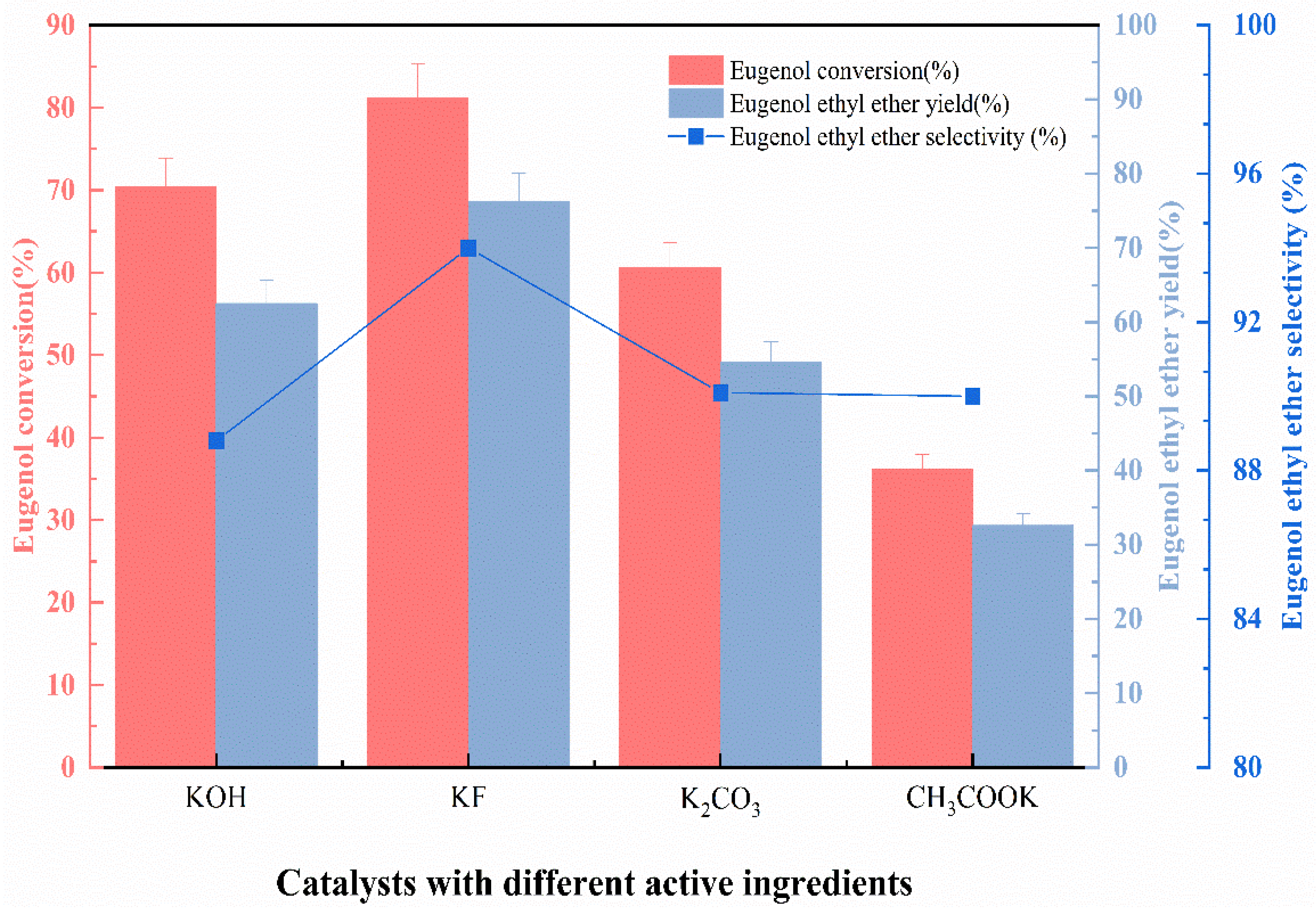
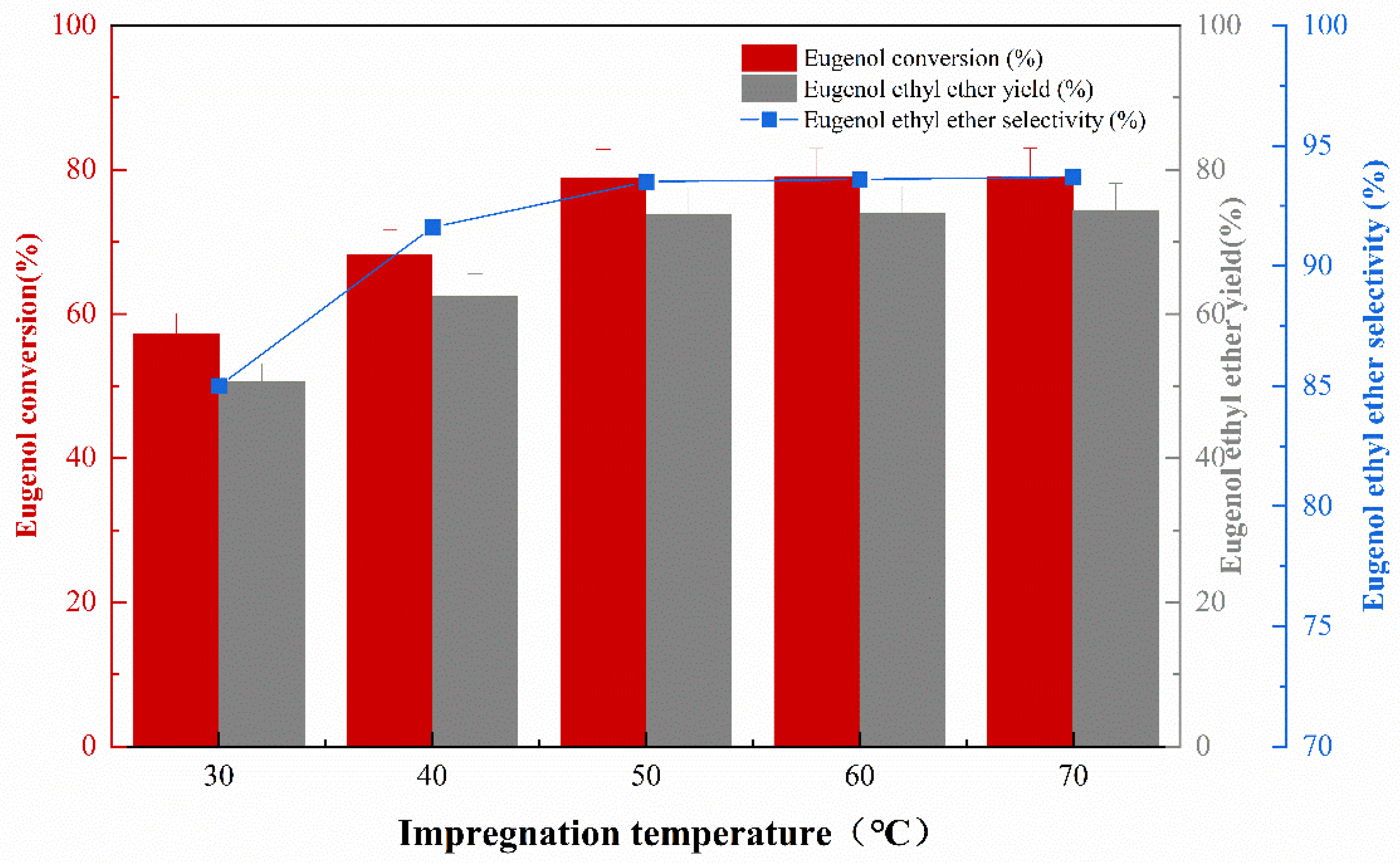
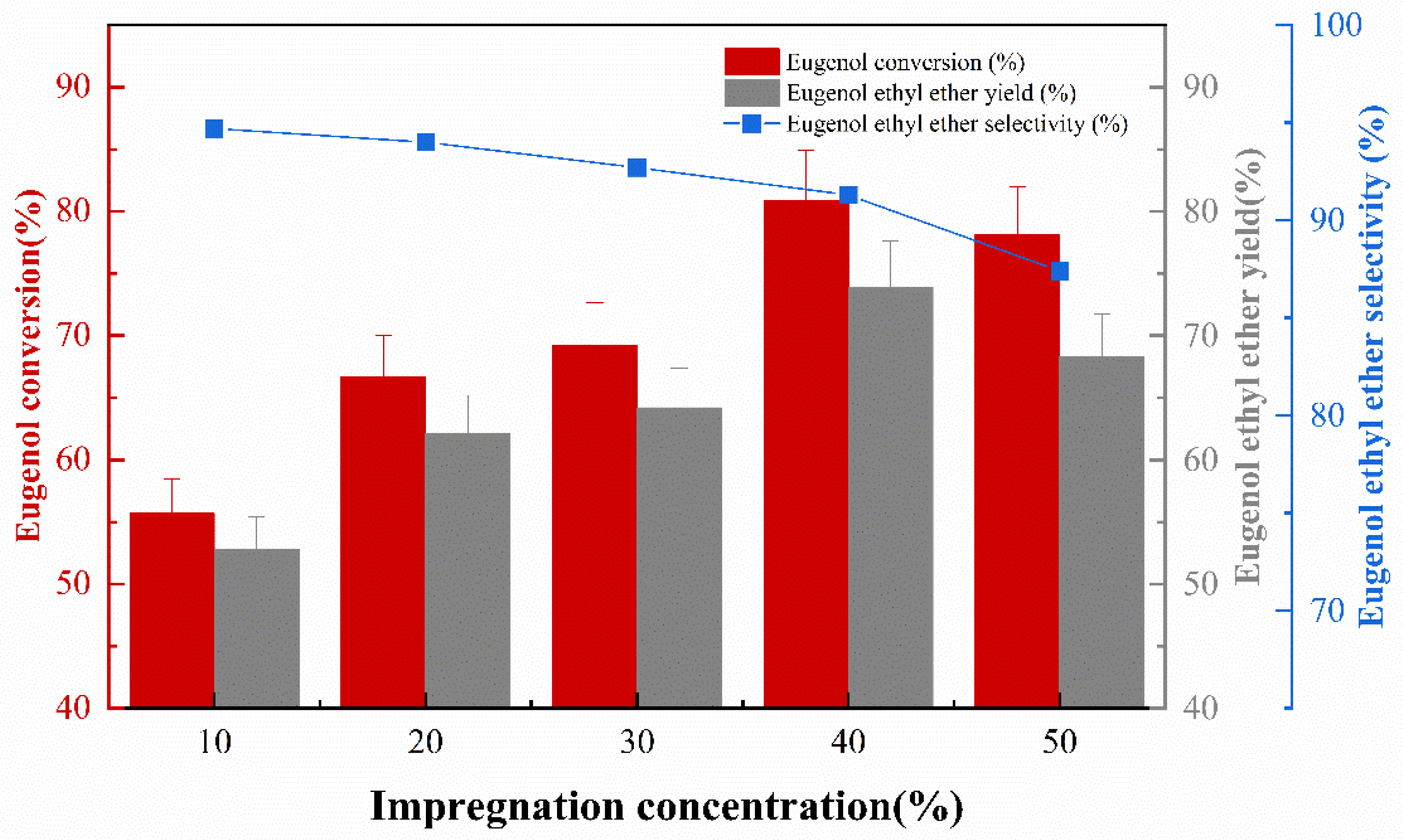



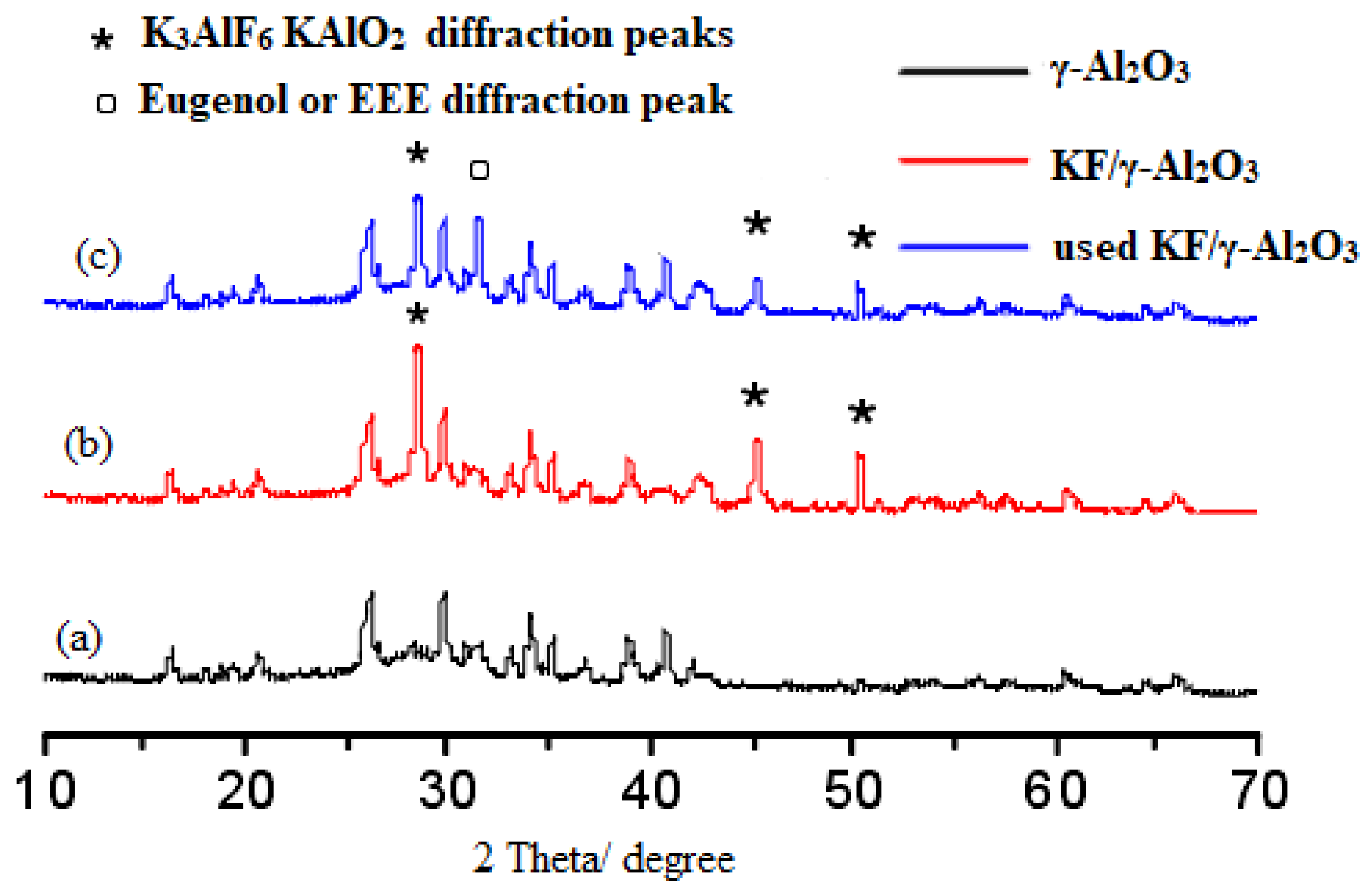
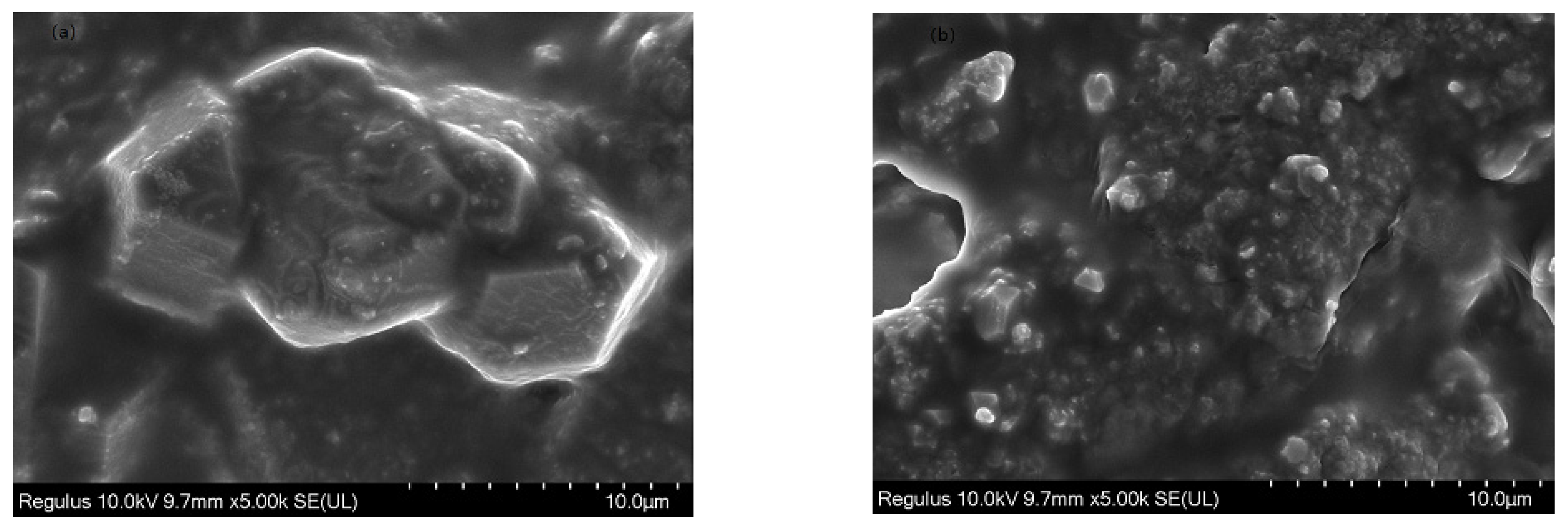
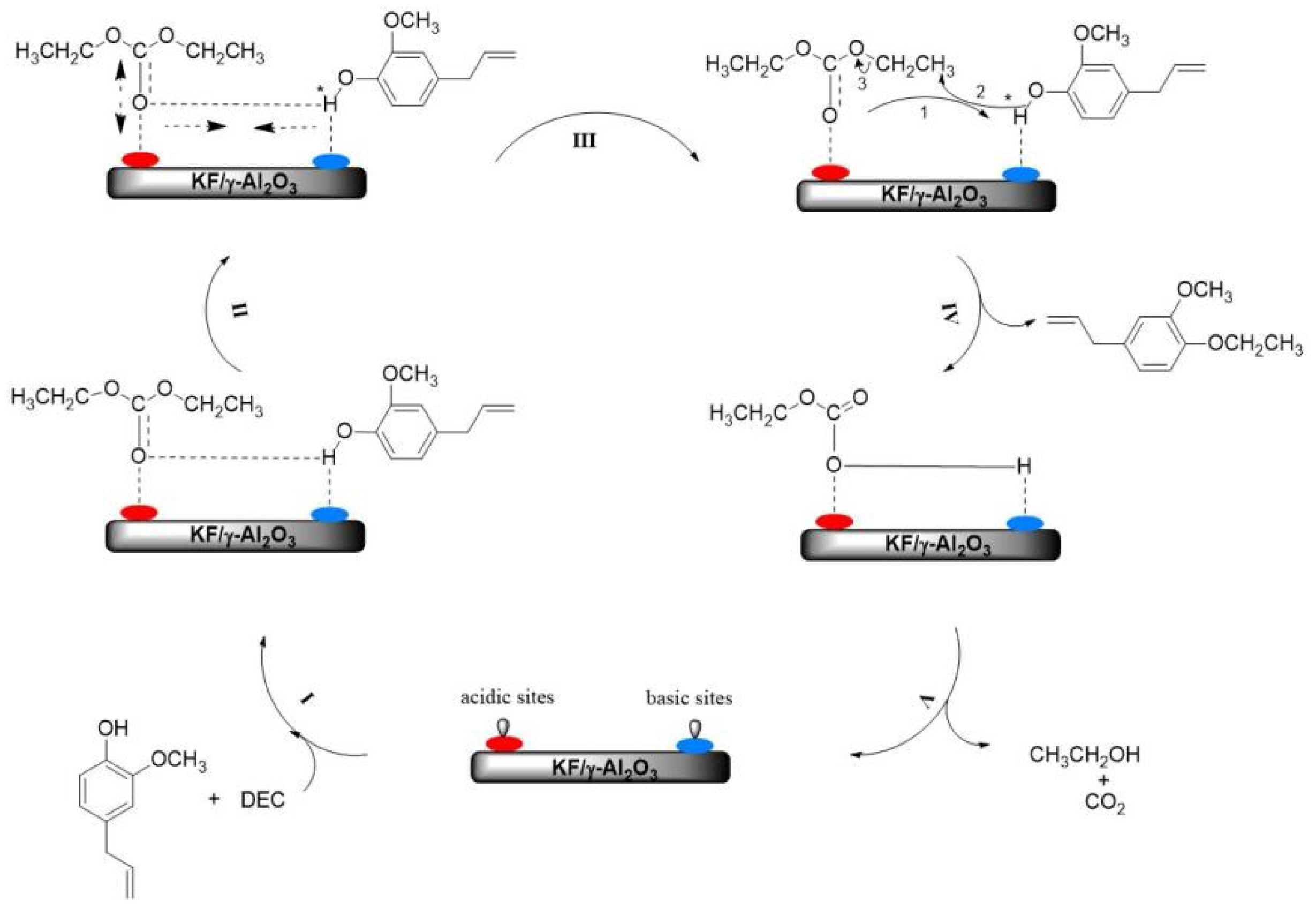

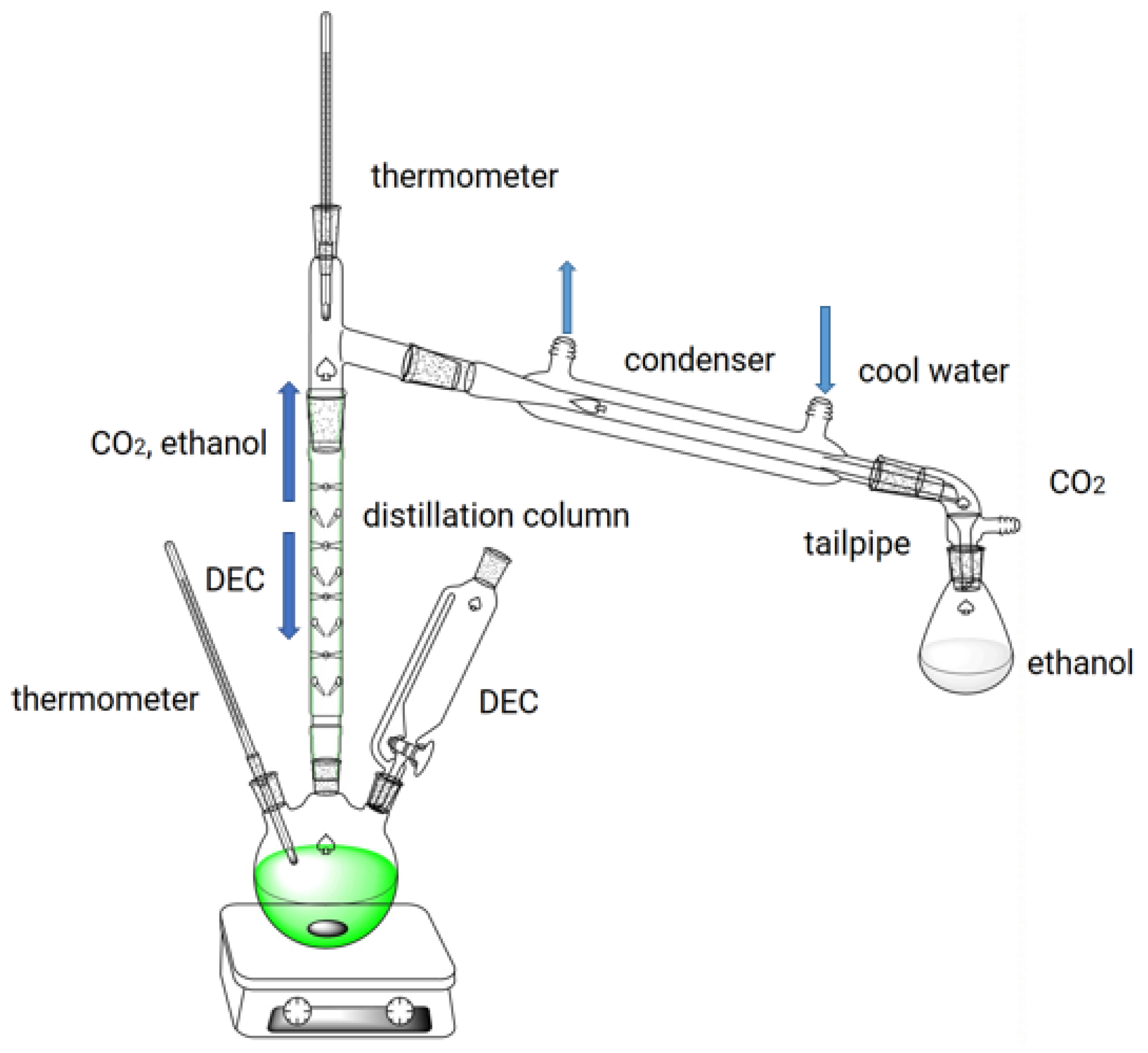

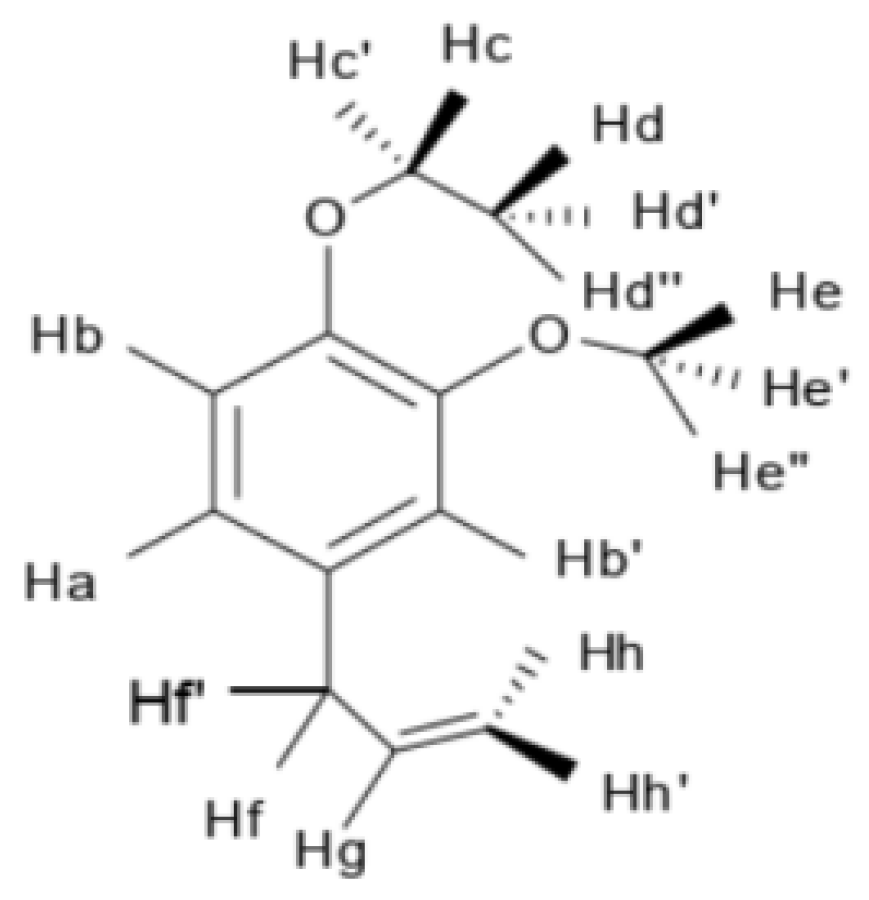
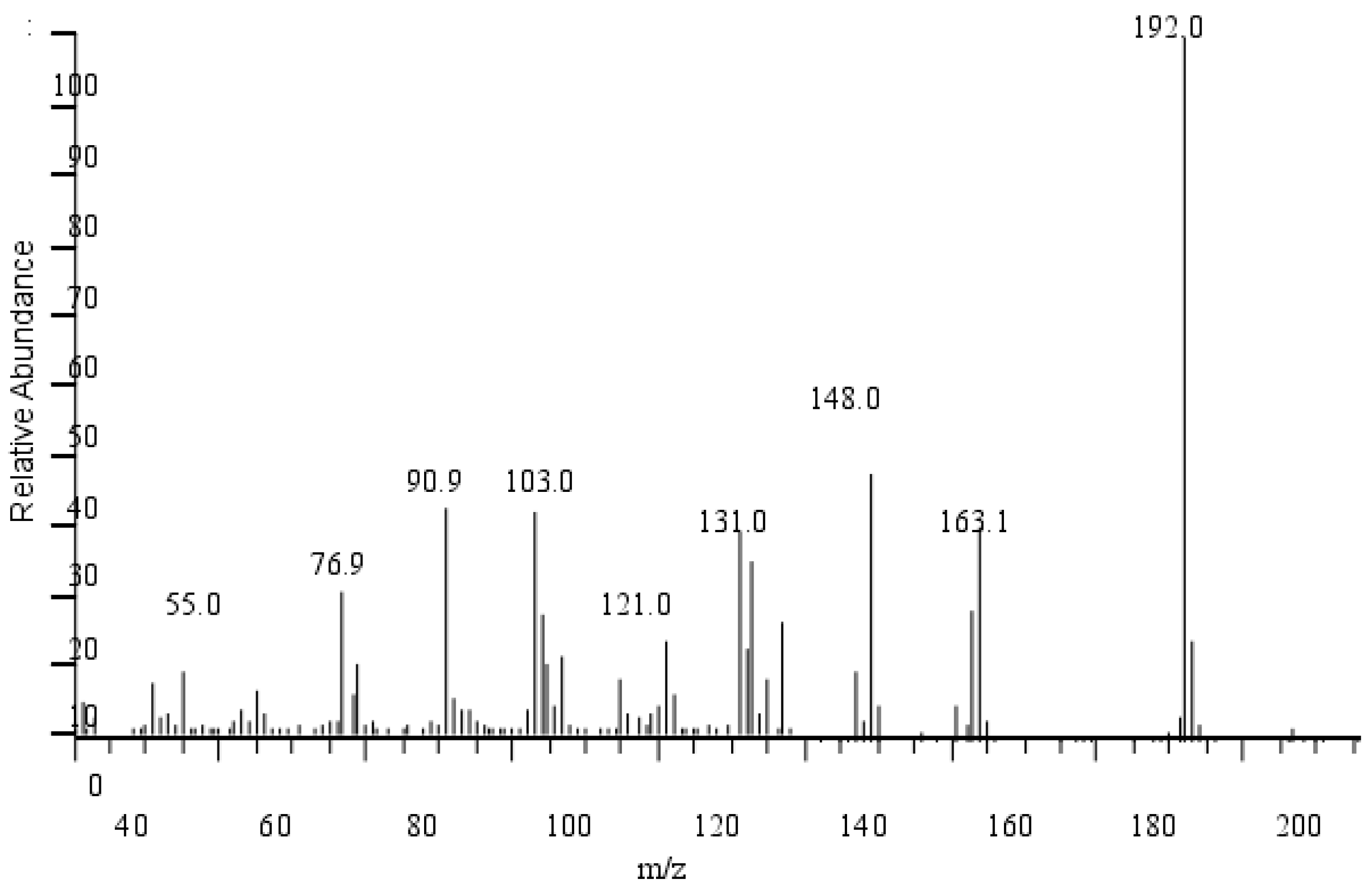
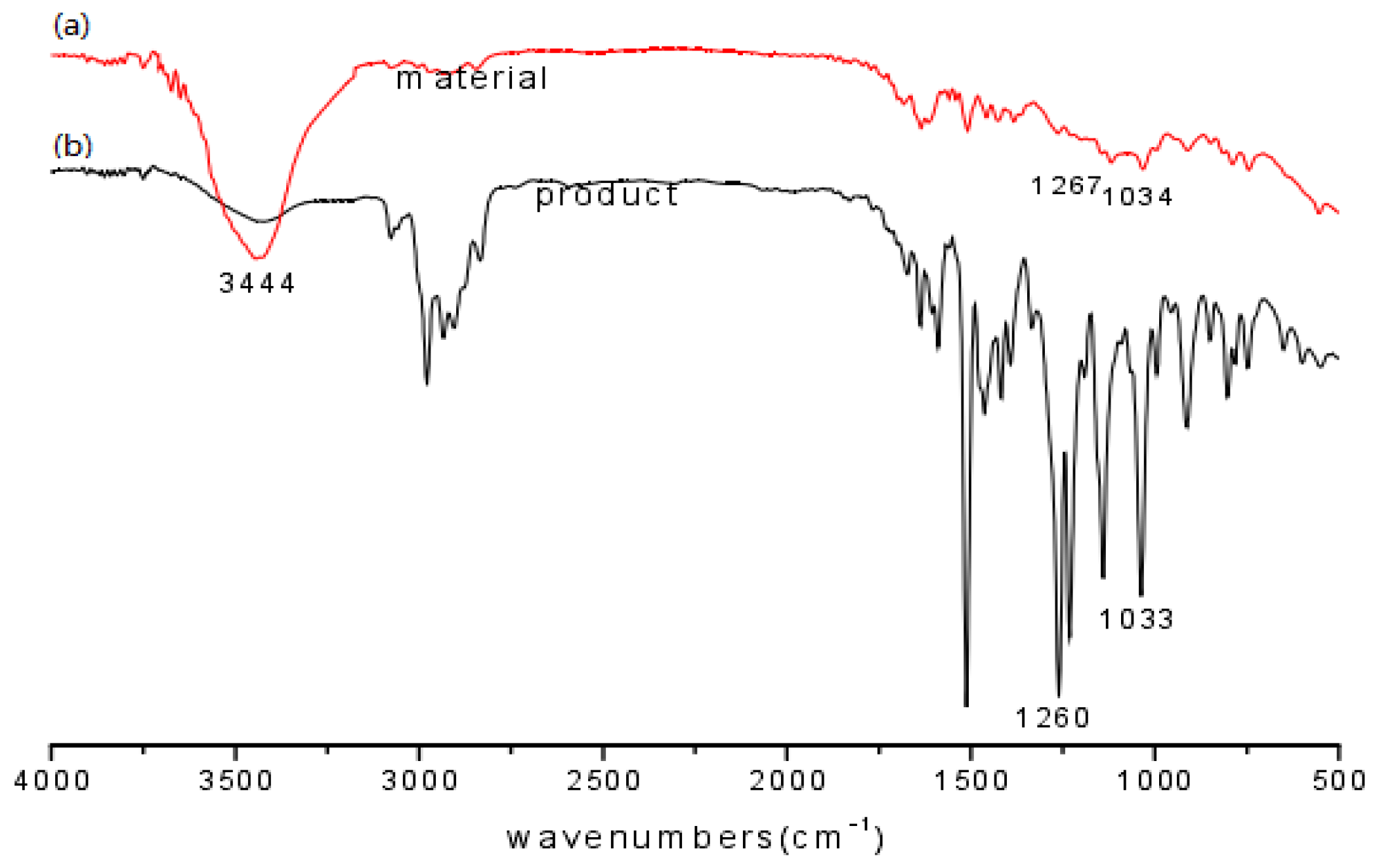
Disclaimer/Publisher’s Note: The statements, opinions and data contained in all publications are solely those of the individual author(s) and contributor(s) and not of MDPI and/or the editor(s). MDPI and/or the editor(s) disclaim responsibility for any injury to people or property resulting from any ideas, methods, instructions or products referred to in the content. |
© 2023 by the authors. Licensee MDPI, Basel, Switzerland. This article is an open access article distributed under the terms and conditions of the Creative Commons Attribution (CC BY) license (https://creativecommons.org/licenses/by/4.0/).
Share and Cite
Zhang, Z.; Zhang, Q.; Liang, J.; Ding, T.; Wang, J.; Zhu, K. Synthesis of Eugenol Ethyl Ether by Ethylation of Eugenol with Diethyl Carbonate over KF/γ-Al2O3 Catalyst. Catalysts 2023, 13, 1163. https://doi.org/10.3390/catal13081163
Zhang Z, Zhang Q, Liang J, Ding T, Wang J, Zhu K. Synthesis of Eugenol Ethyl Ether by Ethylation of Eugenol with Diethyl Carbonate over KF/γ-Al2O3 Catalyst. Catalysts. 2023; 13(8):1163. https://doi.org/10.3390/catal13081163
Chicago/Turabian StyleZhang, Zhihai, Qinyong Zhang, Jilei Liang, Tingting Ding, Jiaying Wang, and Kai Zhu. 2023. "Synthesis of Eugenol Ethyl Ether by Ethylation of Eugenol with Diethyl Carbonate over KF/γ-Al2O3 Catalyst" Catalysts 13, no. 8: 1163. https://doi.org/10.3390/catal13081163
APA StyleZhang, Z., Zhang, Q., Liang, J., Ding, T., Wang, J., & Zhu, K. (2023). Synthesis of Eugenol Ethyl Ether by Ethylation of Eugenol with Diethyl Carbonate over KF/γ-Al2O3 Catalyst. Catalysts, 13(8), 1163. https://doi.org/10.3390/catal13081163




